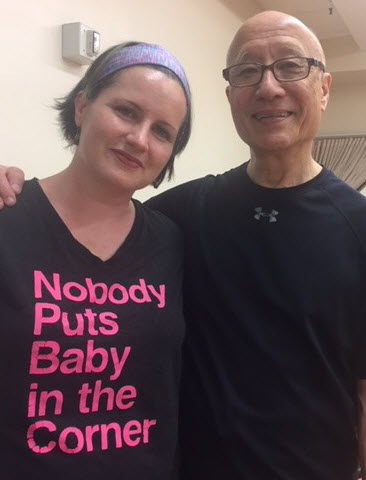Learning New Steps

While many schools are forced to eliminate access to the arts, Franklin Elementary Fine Arts Center in Chicago was established to integrate artistic talent with academic success. Dance teacher M.K. Victorson designed her Fund for Teachers fellowship around intensive teacher workshops that would help her rewrite her existing curriculum, focusing on creative dance, multicultural dance, and genre studies to engage her K-8 learners.
“Ms. V” enrolled in three opportunities – Dance Education Lab (DEL), Broadway Teachers Workshop, and Finis Jhung Ballet in New York City – to rethink how her curriculum can engage all of her dance students whether they are ballet dancers or breakdancers or just not sure about dance at all. Her excellent blog documents her learning, and we share a post written to her students
below…
Dear Students:
I’m sharing some photos here of my incredible workshop last week at DEL: Planet Dance: Multicultural Dance Education. I attended this workshop with all of you in mind as you are always telling me you want to learn different forms of dance. Words can hardly describe the overall experience of this workshop, which had many interesting strands to it. But I’ll say a few:
We began our week by talking about what culture is and what it embodies. (how would you answer ‘What is Culture’? Think about it). Seeking an answer, we:
- looked at our own cultural makeup and created dances about it
- viewed several dances from around the world and analyzed the movement in each
- discussed the reasons why people dance and create dance: recreation, work, communication (to name just a few)
- learned a welcome dance and song from Ghana
- practiced and explored flamenco steps and rhythms from Spain
- viewed a Japanese dance where the dancers used umbrellas
- created new dances inspired by all of these sources, and more!
We danced, created, and we discussed dance in great detail. The question we kept coming back to was:
How do you teach a cultural dance if the culture is not your own?
What do you think, readers? We talked about this at length. We talked about problems, concerns, sensitivity in exploring dance of other cultures. We did not come up with a final answer, but I know that I came away from the experience with much to think about and share with you. This year I will be able to bring in even more residencies that I am hoping will expand our cultural dance knowledge and literacy. Do you have something you can teach me?
Included in the photos are pictures of my collaborative group. At DEL, we finish each intensive week by collaborating in a group and engaging in practice teaching for our fellow teachers. I am very excited about the work my group did because my collaborators and I really worked well together and listened to each other. Crystal, Eva, Monica, and Halley are smart, inquisitive and sensitive beings and I learned so much from them. Oh, they are great dancers, too!
Together we created a lesson around examining bias in dance criticism. It was written for high school, but I think it has relevance to you, my K-8 students. We looked at images and text from a review and created short dances based on it. Then we gave each other feedback on the dance. Finally, we looked at the whole review and discussed the issue of bias and who gets to critique dance. We talked about how to respond to dance by naming what you see before placing judgement. It was fascinating and I am excited to do some of this with you!
I also have some flamenco inspired movement to share with you, courtesy of my teacher, Puela. And there is so much more!
Dancing at you from New York,
Ms. V
M.K. is an eight-year veteran of the Chicago Public Schools and has been teaching and creating in Chicago since 1996. She is passionate about curriculum development, advocacy and inclusion in arts education. A dedicated and energetic teacher, M.K. has been awarded grants from numerous institutions including Chicago Foundation for Education, the Target Corporation, and the Oppenheimer Family Foundation.
 Back to Blogs
Back to Blogs